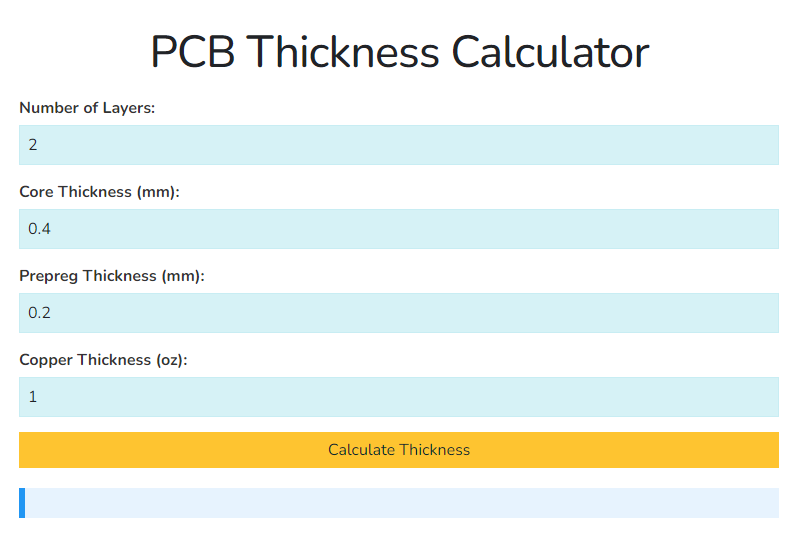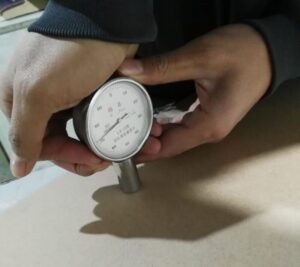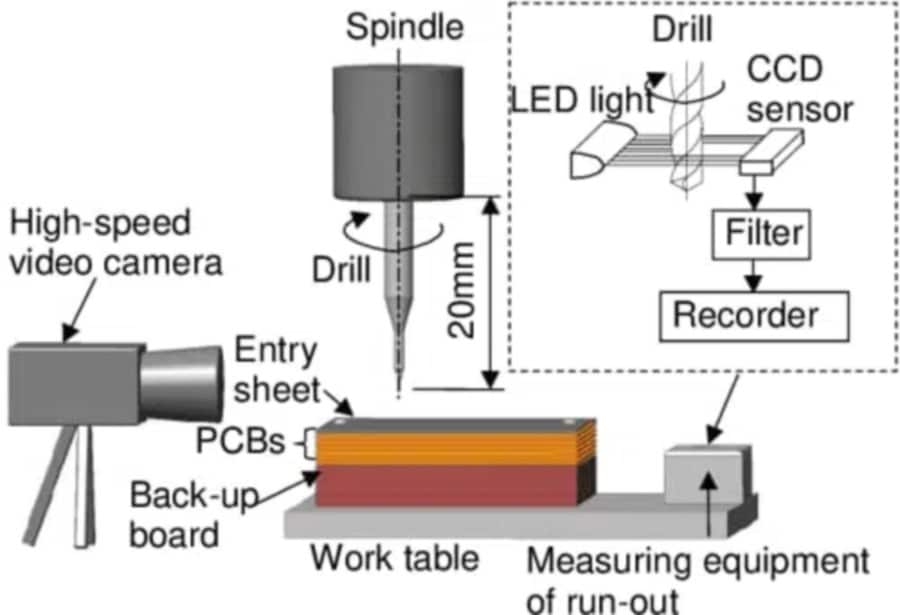PCB Thickness Calculator
Simple PCB Copper Weight Calculator
Mastering PCB Thickness: Your Ultimate Guide to PCB Thickness Calculators
Printed Circuit Board (PCB) thickness is a critical factor in electronics design, directly impacting performance, durability, and manufacturability. PCB thickness calculators are indispensable tools for optimizing these crucial aspects. This comprehensive guide will explore the importance of PCB thickness, how to effectively use thickness calculators, and advanced considerations for your design process.
Why PCB Thickness Matters
PCB thickness plays a pivotal role in determining the overall quality and functionality of electronic devices. Understanding its impact is essential for creating high-performance, reliable products.
Impact on Electrical Performance
The thickness of a PCB significantly affects its electrical characteristics:
- Signal integrity: Thicker boards can reduce signal loss and improve overall signal quality, especially in high-frequency applications.
- Impedance control: PCB thickness is a critical factor in maintaining consistent impedance throughout the board, which is essential for high-speed designs and signal integrity.
Mechanical Strength and Durability
The physical properties of a PCB are directly influenced by its thickness:
- Thermal management: Thicker boards can dissipate heat more effectively, improving overall thermal performance and longevity of components.
- Mechanical properties: Thickness affects the board’s rigidity, flex, and ability to withstand mechanical stress, crucial for devices subject to vibration or impact.
Manufacturing Considerations
PCB thickness impacts various aspects of the manufacturing process:
- Copper weight: The thickness of copper layers affects the overall board thickness and electrical performance, with heavier copper resulting in thicker, more conductive layers.
- Layer stackup: In multi-layer PCBs, the number and arrangement of layers contribute to the final thickness and overall board performance.
PCB Thickness and Design Optimization
Optimizing PCB thickness is crucial for balancing performance, cost, and manufacturability:
- Thinner boards can reduce material costs and allow for more compact designs.
- Thicker boards may offer better electrical and thermal performance but at increased cost and size.
- Finding the optimal thickness involves considering all design constraints and performance requirements.
Key Factors Influencing PCB Thickness Calculations
Several key factors influence PCB thickness, each playing a crucial role in the overall design and performance of the board. Understanding these factors is essential for accurate thickness calculations and optimal design outcomes.
Copper Weight and Trace Width
The relationship between copper weight and PCB thickness is direct and significant:
- Heavier copper results in thicker layers, impacting overall board thickness.
- Trace width affects thickness, with wider traces contributing more to the board’s overall thickness.
- Balancing copper weight and trace width is crucial for achieving desired electrical performance and thickness.
Dielectric Constant and Material Selection
The choice of PCB substrate materials greatly influences thickness and electrical properties:
- The dielectric constant of the substrate material affects signal propagation and impedance.
- Different PCB substrate materials offer varying thickness-to-performance ratios.
- Selecting the right material involves considering factors like frequency requirements, thermal properties, and cost.
Layer Stackup and Signal Integrity
The arrangement of layers in a PCB is critical for both thickness and performance:
- Layer count directly impacts overall thickness.
- The order and spacing of signal, power, and ground layers affect signal integrity.
- Proper stackup design is essential for controlling impedance and minimizing electromagnetic interference.
Using a PCB Thickness Calculator
Effective use of PCB thickness calculators can streamline your design process and ensure optimal results. Here’s how to make the most of these tools:
Step-by-Step Guide
Gather input parameters:
- Copper weight for each layer
- Number of layers
- Dielectric material specifications
- Desired impedance values (if applicable)
Enter the data into the calculator:
- Ensure all units are consistent (e.g., mils, mm)
- Double-check entries for accuracy
Analyze and interpret the results:
- Review the calculated overall thickness
- Check individual layer thicknesses
- Verify if the results meet your design requirements
Practical Examples
Let’s look at two common scenarios:
Example 1: Single-layer PCB Input: 1 oz copper, FR-4 substrate Output: 1.6 mm thickness
This standard configuration is suitable for simple, low-cost applications.
Example 2: Multi-layer PCB Input: 4 layers, 1 oz copper, FR-4 substrate Output: 1.6 mm thickness
This more complex stackup allows for higher component density and better signal integrity.
PCB Thickness Calculator Tools Comparison
Several tools are available for PCB thickness calculations. Here’s a brief comparison:
Saturn PCB Toolkit:
- Pros: Comprehensive, free, available offline
- Cons: Steeper learning curve
PCB Stackup Planner:
- Pros: User-friendly interface, cloud-based
- Cons: Limited free version
Polar Instruments Si9000e:
- Pros: Highly accurate, industry-standard
- Cons: Expensive, may be overkill for simple designs
Choose the tool that best fits your design complexity and budget constraints.
Tips for Accurate Calculations
To ensure precise results from your PCB thickness calculator:
- Always use the most up-to-date material specifications
- Consider manufacturing tolerances in your calculations
- Verify results with multiple calculation methods when possible
- Consult with your PCB manufacturer for their specific capabilities and recommendations
Advanced PCB Thickness Calculator Applications
For complex designs, consider these advanced aspects when using PCB thickness calculators:
Impedance Control Techniques
Precise impedance control is crucial for high-speed and RF designs:
- Use PCB thickness calculators in conjunction with impedance calculators
- Adjust trace width and dielectric thickness to achieve target impedance values
- Consider differential pair impedance for high-speed digital designs
Thermal Management Strategies
Effective thermal management often requires careful thickness considerations:
- Use thicker copper layers for improved heat dissipation
- Consider thermal vias and copper planes in your thickness calculations
- Employ specialized thermal simulation tools to optimize board thickness for heat management
Mechanical Properties and Flexibility
PCB thickness significantly impacts mechanical characteristics:
- For rigid boards, calculate minimum thickness needed for required stiffness
- For flex and rigid-flex PCBs, use specialized calculators that account for bend radius and flexibility requirements
- Consider the impact of thickness on vibration resistance and overall durability
Case Studies and Practical Applications
Real-world examples illustrate the importance of proper PCB thickness calculations:
Case Study 1: High-Frequency PCB Design
- Challenge: Maintaining signal integrity at 5 GHz
- Solution: Used PCB thickness calculator to optimize layer stackup and achieve 50 Ohm impedance
- Result: 30% reduction in signal loss compared to initial design
Case Study 2: Power Distribution in PCBs
- Design consideration: High current-carrying capacity required
- Solution: Utilized PCB thickness calculator to determine optimal copper weight
- Outcome: Achieved target current capacity while minimizing board thickness, resulting in 15% cost reduction
Case Study 3: Flex PCB in Wearable Device
- Design process: Balanced flexibility and durability through iterative thickness calculations
- Benefit: Achieved 40% thickness reduction compared to rigid PCB alternative
- Challenge: Required specialized manufacturing process, increasing production time
Industry Standards and Best Practices
Adhering to industry standards ensures quality and compatibility:
IPC Standards for PCB Thickness
Key standards to consider:
- IPC-2221: Generic Standard on Printed Board Design
- IPC-6012: Qualification and Performance Specification for Rigid Printed Boards
To comply with these standards:
- Use IPC-recommended thickness tolerances in your calculations
- Follow IPC guidelines for conductor spacing based on voltage requirements
- Adhere to IPC-specified minimum dielectric thickness between layers
Best Practices in PCB Design
Follow these best practices for optimal PCB thickness design:
- Always consider the entire PCB stackup, not just individual layers
- Design for manufacturability by avoiding extremely thin or thick boards
- Regularly update your material libraries with the latest specifications
- Collaborate closely with your PCB manufacturer throughout the design process
Tools and Software for PCB Design
Leverage modern tools for accurate thickness calculations and overall PCB design:
Popular PCB Design Tools
Altium Designer:
- Pros: Comprehensive design suite, powerful stackup manager
- Cons: Steep learning curve, expensive
Eagle:
- Pros: User-friendly, extensive component libraries
- Cons: Limited layer count in cheaper versions
KiCad:
- Pros: Open-source, free, growing community support
- Cons: Less advanced features compared to commercial tools
Software for Impedance and Thermal Analysis
Polar Instruments Si9000e:
- Specialized for impedance and insertion loss calculations
- Integrates well with many PCB design tools
Ansys:
- Comprehensive thermal and mechanical analysis
- Can simulate complex multi-physics scenarios
Material Selection and Suppliers
Choosing the right materials is crucial for achieving desired PCB thickness and performance:
Choosing the Right Materials
Consider these factors when selecting PCB substrate materials:
- Dielectric constant and its stability across frequencies
- Loss tangent for high-frequency applications
- Thermal conductivity for heat management
- Coefficient of thermal expansion for reliability
Compare common substrate materials:
- FR-4: Standard, cost-effective, suitable for most applications
- Rogers RO4350B: High-frequency performance, more expensive
- Isola Astra MT: Balanced cost and high-frequency performance
Leading Material Suppliers
Top PCB material suppliers include:
Rogers Corporation:
- Specializes in high-performance materials
- Wide range of dielectric constants available
Isola Group:
- Offers materials for various applications
- Strong in both standard and high-speed materials
Panasonic:
- Known for reliable, high-quality materials
- Offers halogen-free options
Conclusion
Mastering PCB thickness calculations is crucial for optimizing your electronic designs for performance, manufacturability, and cost-effectiveness. By leveraging PCB thickness calculators and following industry best practices, you can significantly improve your design outcomes.
Key takeaways:
- Understand the critical impact of PCB thickness on electrical and mechanical performance
- Utilize PCB thickness calculators effectively, considering all relevant factors
- Apply advanced techniques for impedance control and thermal management
- Stay updated with industry standards and material innovations
Next steps:
- Integrate PCB thickness calculators into your design workflow
- Experiment with different materials and stackups to optimize your designs
- Consult with PCB manufacturers to align your designs with their capabilities
Remember, the right PCB thickness is key to creating high-performance, reliable electronic products. Start applying these principles today to elevate your PCB designs to the next level.
FAQ
What is the standard thickness for PCBs? While there’s no single standard, common thicknesses range from 0.8mm to 1.6mm for rigid PCBs. The specific thickness depends on the application and design requirements.
How does PCB thickness affect signal integrity? PCB thickness impacts impedance control and signal propagation. Thicker boards can reduce signal loss but may also increase overall size and weight.
Can I use a PCB thickness calculator for flex PCBs? Yes, but flex PCBs often require specialized calculators that account for the unique properties of flexible materials and bend radii.
What’s the relationship between copper weight and PCB thickness? Heavier copper weights increase the overall PCB thickness. For example, 2 oz copper is twice as thick as 1 oz copper.
How do I choose the right PCB thickness for high-frequency applications? For high-frequency designs, focus on maintaining consistent impedance. Use impedance calculators in conjunction with thickness calculators to determine the optimal board stack-up.




